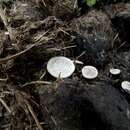Biology
provided by Arkive
Nail fungus fruiting bodies are most frequently seen in the UK in the months from October to May inclusive. The spores are ingested by livestock whilst grazing, and passed out with their dung. The spores germinate and form the mycelium of the nail fungus, eventually producing the visible fruiting bodies after the dung has had time to weather.
Conservation
provided by Arkive
Nail fungus is listed in the UK Biodiversity Action Plan (UK BAP) and included in English Nature's Species Recovery Programme. The Dorset populations have been monitored since their discovery in 1999, and aspects of the ecology of the species are being studied. Re-introduction into other suitable areas may be a long-term possibility.
Description
provided by Arkive
This rare fungus, found on the dung of ponies and horses, takes its name from the resemblance of the fruiting bodies to nails. The stalk of the 'nail' is dark-brown, almost black in colour, whilst the expanded head is buff-white dotted with small black pores.
WARNING: many species of fungus are poisonous or contain chemicals that can cause sickness. Never pick and eat any species of fungus that you cannot positively recognise or are unsure about. Some species are deadly poisonous and can cause death within a few hours if swallowed.
Habitat
provided by Arkive
Nail fungus occurs only on the dung of ponies and horses which have fed on un-improved acidic grassland and heathy vegetation. The fruiting bodies are most frequently seen on well-weathered dung, and may not occur on dung that has been heavily disrupted by foraging birds or animals, possibly due to subsequent desiccation. In Europe, it has been reported as growing on cattle dung.
Range
provided by Arkive
In the UK, nail fungus has in recent years been largely restricted to parts of the New Forest, Hampshire, until 1999 when a population was discovered on heathland in Dorset. This latter population appears to be persisting. It also occurs in a few places in south-east Europe, and is now considered to be one of the rarest fungi in Europe.
Status
provided by Arkive
Classified as Endangered in the UK.
Threats
provided by Arkive
Nail fungus has declined as a result of changes in agricultural practices, in particular the decline in the use of horses and ponies, and the loss of unimproved grassland and heathland.
Associations
provided by BioImages, the virtual fieldguide, UK
In Great Britain and/or Ireland:
Animal / dung saprobe
stalked stroma of Poronia punctata is saprobic in/on dung or excretions of dung of Equus caballus
Other: major host/prey
Animal / dung saprobe
stalked stroma of Poronia punctata is saprobic in/on dung or excretions of dung of Bos taurus (domestic)

